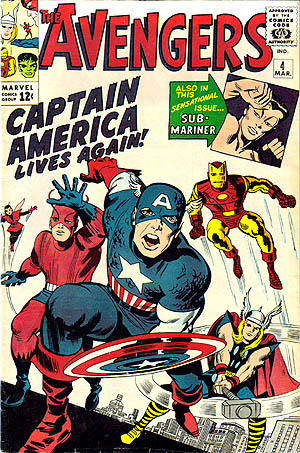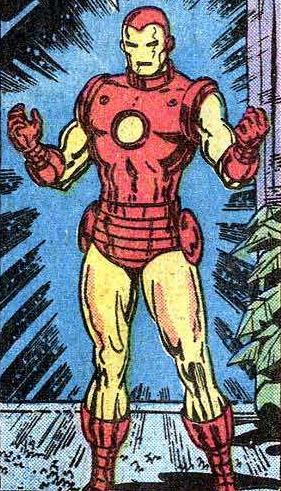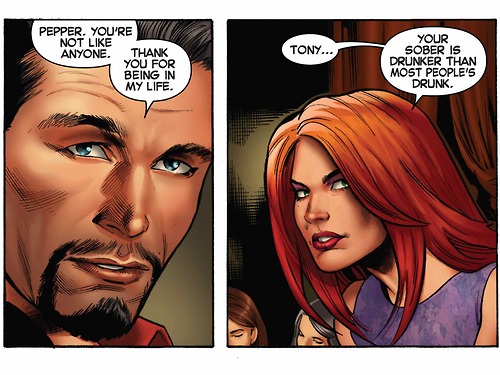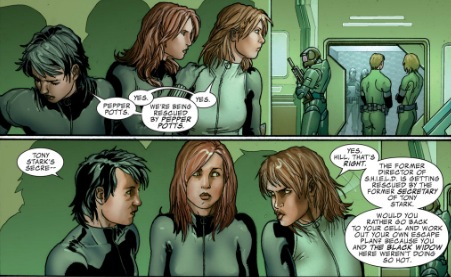“They say that the best weapon is the one you never have to fire. I respectfully disagree. I prefer the weapon you only have to fire once. That’s how Dad did it, that’s how America does it, and it’s worked out pretty well so far. I present to you the newest in Stark Industries’ Freedom line. Find an excuse to let one of these off the chain, and I personally guarantee, the bad guys won’t even wanna come out of their caves. Ladies and gentlemen, for your consideration… the Jericho” – Tony Stark, Iron Man (2008)
For our final project, my group and I decided to take a deeper look at the famous Marvel comics known as The Avengers. The Avengers include a charismatic group of men and women who were brought together for the sole purpose of combining powers, and standing as the most dynamic, and monumental superhero team the world had ever seen. Each character was first given at least one film based upon their original comics from the mid 1900’s in order to allow the audience to understand the backstory to the uprising of The Avengers. Although comics, especially comics written in the mid 20th century, obtain a generous amount of stereotypes, sexual exploitation, and predictable storylines, my group and I decided to focus on the aspects of these characters that are commonly overlooked. In the superheroes’ individual films, as well as their collective films, countless examples of the lenses we have been discussing are apparent. That is, if you pay close enough attention. The comic I will be focusing on is the film Iron Man. Throughout the film Iron Man, the particular lenses that emerge and inspire it’s audience include the challenging of female-in-comic gender stereotypes, science fiction folklore, as well as historical events that are relative to substantive United States war conflict.

The comic Iron Man, which was eventually turned into a screenplay directed by Jon Favreau in 2008, is a humorous and captivating story which displays many aspects and lenses of American Culture that we have been discussing throughout our course. The main character “Tony Stark”, which is played by award winning actor Robert Downey Jr., is a multi-billion dollar weapon designer and runs into trouble while on convoy with United States military soldiers in Afghanistan. Tony was overseas with the military to demonstrate his company’s latest invention which was an advanced super-missile system which was extremely successful, and as Tony fled with the convoy, they were attacked and Tony became severely injured and captured by masked Afghan terrorists. He resumed consciousness in a cave where he learned that he was saved by the insertion of a device into his chest. He was operated on by a fellow captive who explained that he tried his best, but wasn’t able to remove all of the metal shards stuck in his flesh and bloodstream. Eventually Tony and the life-saving captive build a deadly weapon-inspired suit of armor and are able to escape terrorist captivity, allowing them both to return home.
“Barely able to operate his new legs, Stark nevertheless confronts his nemesis: ‘Have you never seen an iron man before?’ he taunts. Wong-Chu (a stand-in for Ho Chi Minh, not to mention the Viet Minh insurgency in South Vietnam generally) stammers, ‘You — you are not human! You are machine!'” (Glenn p5).

As the innovator that Tony Stark is, he worked furiously for days without sleep until finally he created a new version of the suit of armor called Mark II. Something that started simply to save his life turned into a revolutionary advancement in the world of technology and weapons. He recreated the suit with titanium, perfected the flight system, and added a daring and fierce red trim. He began to experiment with the suit and as soon as he became comfortable with operating the new technology, he fled straight to Gulmira where he was awaited by terrorists and civilians prepared to capture and execute the disguised Tony Stark. Within seconds, he defeated the anarchists and although had some minor setbacks on the way home, made it out of the Middle East alive.

Aside from two or three people, nobody knew the ongoings of Tony Stark’s newest invention and he found it best to keep it a secret from some of his closest friends, as well as the government. The government noticed unmonitored flight activity and questioned Stark, but he remained silent. It was not until the end of the film that Tony admits to being the ominous and valiant “Iron Man” in an impromptu press meeting. Although Tony disguised as Iron Man was frightening to most, we later realized that the comic superhero provided hope during times of crisis. The chronicles of the development and execution of the titanium suit included mass destruction of buildings, streets, and city sidewalks. Nevertheless, Iron Man served as a symbol of optimism and safety to American society.
Of all the lenses we have been discussing in class, a few were apparent in the film Iron Man. One lense in particular that stood out to me was the schematics of gender roles. The leading females in comics and comic-based films are typically presented as the hopeless damsel in distress who needs to be rescued. This gender stereotype was challenged in the comic Iron Man when we met Tony Stark’s best friend and personal assistant Virginia “Pepper” Potts. Pepper’s responsibilities range from handling Stark’s everyday needs, to sending away his one-night-stands the following morning. Although Tony obtains a fair amount of character flaws, Pepper always remained truly fond of him and kept his best interests at heart.

There are two aspects to Pepper that made her stand out from the norm. There was always a sort of romantic tension between Pepper and Tony, and Tony was often seen making lighthearted, suggestive comments about their friendship and the romanticism between them. These comments often ended with Pepper expressing discomfort, but she would also exhibit her mutual understanding through a kiss on the cheek. Pepper was very clear about wanting to maintain their professional business-minded relationship in the film, but her body language and facial expressions always seemed to suggest otherwise. Pepper was the first female lead in a comic that I recognized as being powerful and in control.

Another very important part about Pepper was that she was unusually present in the action of the film as well. Toward the end of the film, she was a key component in Tony’s success of defeating his rivals and overcoming monumental obstacles. When Pepper was held captive by Obadiah Stane (Tony’s friend that eventually turned against him) she never once cried for help. Instead, she utilized her wit to hack into Stane’s computer and retrieve detrimental criminal evidence while also utilizing her physical capabilities to free herself in an attempt to assist Tony in saving the day. It was extremely unexpected to see a female lead in a superhero film evade being captured using her wit, take out the rival, and romantically turn down the hero because of his grotesque, bachelor personality. However, any true Marvel Comic fans know that eventually Tony and Pepper end up together happily… for a while. Pepper Potts is an extremely dynamic character and is very well respected by not only myself, but other feminist-minded individuals who enjoy when gender stereotypes are challenged.
Another lense and aspect of American Culture that we have discussed previously is the use of folklore in entertainment. Folklore has been apparent in storytelling dating all the way back to ancient times. Thousands of years ago, even Egyptians utilized hieroglyphics to document stories and folklore of that time. The difference between ancient folklore and the folklore present in these Marvel comics is the genre. In American Culture, I would consider comics, or Iron Man specifically, to be science-fiction folklore. Folklore is defined as “the traditional beliefs, customs, and stories of a community, passed through the generations by word of mouth” (Dictionary.com). Many aspects of folklore are fictional, mythical, or over-dramatized. The aspects of Iron Man and The Avengers that were slightly mythical and over-dramatized were the advanced weapon technology seen in Tony Stark’s suit of armor, as well as the actual existence of “super powers” or super human ability. It is apparent that such things do not exist in real life, however I admire the effect that superhero comics and films have on younger audiences. Superheroes in these comic films inspire children to be heroes and instill a will to always do the right thing.
The Avengers and Iron Man contain not only aspects relevant to the content and lenses we have been focusing on, but also serve to inspire newer generations to stray from cultural stereotypes and challenge societal norms.
REFERENCES
http://archive.boston.com/bostonglobe/ideas/brainiac/2008/04/we_are_iron_man.html
https://thehathorlegacy.com/iron-man-pepper-potts/
http://www.imdb.com/title/tt0371746/quotes
https://io9.gizmodo.com/the-complete-history-of-marvel-superhero-movies-1990-2-1691891718